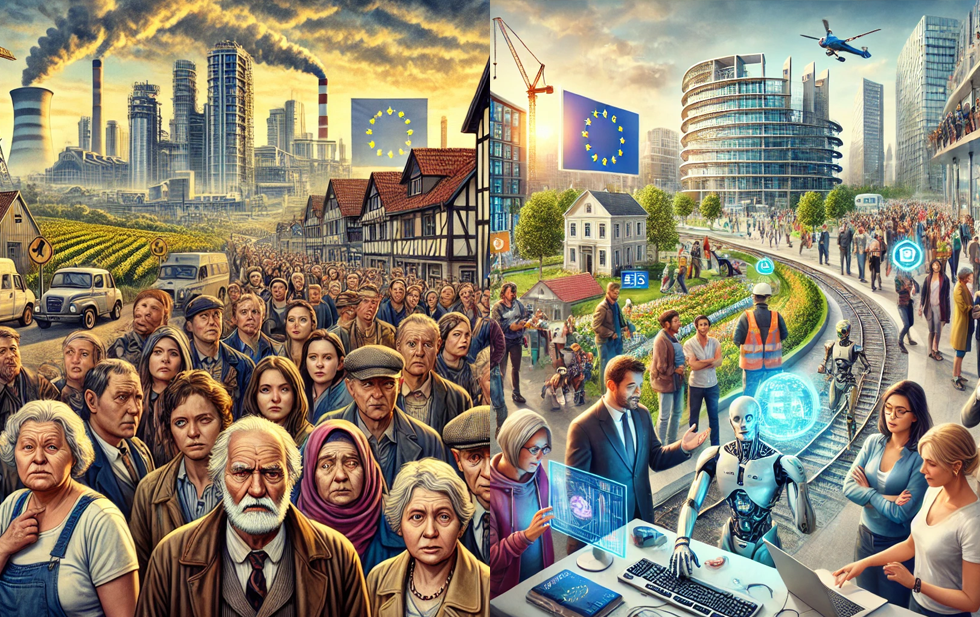Europe 2025: Exploring Alternative Futures
Europe 2025: Exploring Alternative Futures
The future is of course dependent on numerous variables.
7 October 2024
BACK TO BLOGS

At Shaping Tomorrow, we’re working hard to develop a brand new Scenarios service to enable you to explore alternative futures with the aid of two easy sliders:
-
Mood (fearful - hopeful)
-
Timeframe (2025 - 2065)
to quickly generate scenarios for your greater understanding of possible futures that could influence your decision making today. Additionally, each scenario comes with a strategic follow-up question to help you dig deeper if you like.
Here’s an example:
Scan: Declining middle class in Europe
Timeframe: 2035
Scenario 1:
Mood: Fearful
Scenario 2:
Mood: Hopeful
Creating both these scenarios took me about 90 seconds.
Fearful Scenario
Potential Fear in 2035: Economic Collapse Due to Shrinking Workforce
Looking toward 2035, Europe's socio-economic landscape may face a daunting fear: an existential workforce crisis. With a projected drastic decline in the working-age population, as highlighted by the estimated 45 million worker shortfall over the coming decades, industries across Europe might find themselves grappling with unprecedented labor shortages (International Organization for Migration). This anticipated shortage not only threatens economic productivity but also challenges the sustainability of public services, as fewer workers contribute to tax revenues required to support an aging population.
Economic repercussions from demographic changes could be significant. Germany, for example, faces a potential decline in economic growth due to its aging demographic and shrinking workforce (Fortune Europe). These concerns are exacerbated by the erosion of industrial competitiveness. As Europe strives to maintain its position in the global market, a reduced labor force might weaken its industrial heartland, leading to lower medium-term economic growth and increased reliance on technology and automation to fill workforce gaps (Bruegel).
Societal and political ramifications are equally concerning. The economic anxieties arising from demographic shifts are likely to fuel political instability, bolstering far-right movements that could hinder unified policy responses to migration and sustainability challenges (The Guardian). As the fear of a diminishing global influence looms, European nations might cultivate more conservative policies, potentially impacting collaboration and innovation on the continent (Carnegie Europe). Policymakers are therefore urged to craft comprehensive strategies that can bridge the gap between economic demands and social expectations to stave off these looming fears (European Research Executive Agency).
Follow-up Question:
What strategies can European leaders implement to mitigate the economic impacts of a shrinking workforce by 2035?
Hopeful Scenario
Emerging Hope for Europe in 2035 Amidst Demographic and Economic Challenges
As Europe approaches 2035, there is an emerging potential for hope amidst the demographic and economic challenges. Policymakers are increasingly focusing on integrating advanced technologies and innovative governance models to mitigate the impact of a shrinking workforce. Automation, AI, and robotics are seen as crucial tools that can enhance productivity and offset labor shortages. Investment in these areas is expected to drive a new wave of industrial transformation, helping to maintain Europe's competitiveness on the global stage (CapX).
Within this context, migration policies are also being revisited to attract skilled labor from around the world. Enhanced mobility frameworks are being proposed to facilitate the movement of professionals and students, thereby replenishing the talent pool. Such measures aim not only to address immediate labor shortages but also to foster a culturally diverse and dynamic workforce that can drive innovation and economic growth (International Organization for Migration).
To complement these efforts, significant resources are being channeled into education and re-skilling programs. By equipping the current and future generations with the necessary skills to thrive in a technologically advanced economy, Europe hopes to create a sustainable and inclusive economic environment. These strategic initiatives are targeted to rebuild public trust and optimism, ensuring that the citizens are prepared for and resilient to the forthcoming societal changes (Carnegie Europe).
Follow-up Question:
How effective are the new technologies in mitigating the impact of Europe's shrinking workforce?
We feel this will help our clients to quickly explore alternative futures by examining different scenarios.
If you would like to try this out yourself, just reply to this email. We’d love to hear what you think.
Stay curious,
Matthew Richardson
CEO, Shaping Tomorrow
